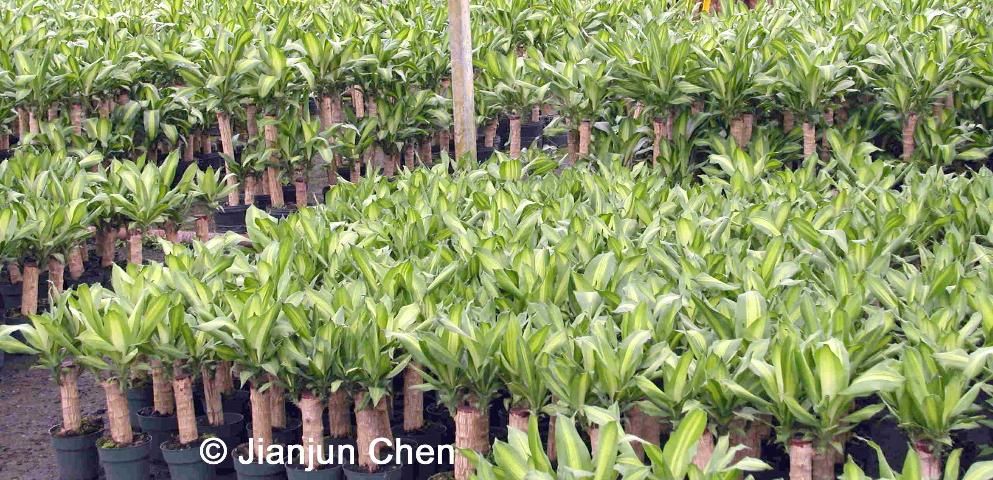Dracaena, a genus in the family Agavaceae, is composed of about 40 species. Unlike most monocots, Dracaenas are evergreen shrubs or trees most frequently characterized by long linear leaves often on unbranched stems or trunks. Mature heights reach from two to over 50 feet. One species, D. americana, is indigenous from Mexico to Costa Rica; all other species are native to Africa, India, Madagascar, or islands in the South Pacific. Cultivated species, excluding D. draco that may be grown for its red resin, are grown for their ornamental value. This article describes common species and cultivars in the foliage plant industry (See Table 1), provides guidelines on their culture and interior use, and lists physiological problems that may be encountered in both production and interiorscape use (See Table 3).

Credit: Jianjun Chen, UF/IFAS
Cultural Guidelines
Propagation
Rooting of tip cuttings, air layering, and cane cuttings are the primary methods of Dracaena propagation. Air layering or cane cuttings are mainly used for large specimens, and tip cuttings are used for producing the smaller Dracaena species.
Production
Sphagnum peat, pine bark, vermiculate, or perlite (leach before using) can be volumetrically combined to formulate media for plants in smaller containers while media for larger plants may contain 10–20% coarse sand to keep plants from wind tipping. Media should have good moisture capacity and aeration, soluble salts of 1–2 dS/m, and pH of 6.0 to 6.5. A pH lower than 6.0 may cause leaf chlorosis while a media pH above 6.5 will cause iron deficiency.
Dracaena sp. should be grown in a shadehouse with a temperature of 70 to 90°F and a relative humidity of 60 to 100%. Temperatures above 90°F cause foliar chlorosis of 'Janet Craig' and notching of 'Warneckii'. Controlled-released or water-soluble fertilizers with micronutrients or a combination of both can be used for Dracaena production. Fertilizers with low boron and fluoride levels and an N:P:K ratio of 3:1:2 or 3:1:3 are best. The suggested application rate is 3 lb N per 1,000 sq. ft per month. Table 2 provides a guide for determining if Dracaenas are appropriately fertilized based on leaf analysis. Fertilization should be reduced by 50% or stopped one month before shipment.
Dracaenas for interior use should be grown under shade. D. arborea, fragans, and marginata can be grown under 63 to 73% shade (3250 to 4000 fc) and the other species under 73 to 80% shade (2500 to 3250 fc). Although the yellow color of 'Massangeana' and the red tones in D. maginata cultivars increase with higher light, the variegation percentage in other Dracaena will decrease if grown under shade levels lower than 80%.
Shipping and Interior care
Dracaena should be shipped at temperatures between 55 and 65°F. Once plants are placed indoors, it is advisable not to re-pot or fertilize for about four weeks because plants do not need additional stress. Plants should not be fertilized if soluble salts are 1.0 dS/m or more. If soluble salts levels are higher than 3.0 dS/m, percolation of the media with water may help reduce potential leaf burning problems. Media should be kept moist. Temperatures of 70 to 80°F are most appropriate, and drafts should be avoided (See Table 3).